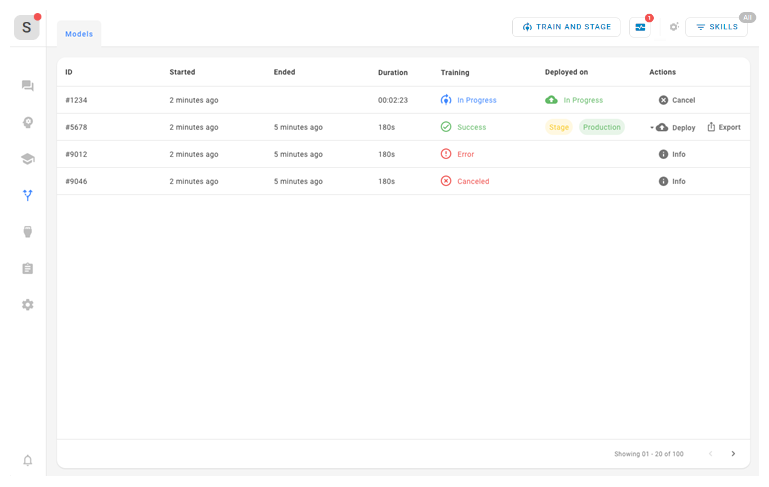This page provides the essential tasks required to deploy an Mpower Agent![]() A virtual agent created with CXone Mpower Agent Builder that can handle voice or chat interactions. with Agent Builder. This is the seventh step in the Mpower Agent implementation process.
A virtual agent created with CXone Mpower Agent Builder that can handle voice or chat interactions. with Agent Builder. This is the seventh step in the Mpower Agent implementation process.
Agent Builder uses a two-stage deployment process, so you can deploy to either stage or production. Mpower Agents in stage are still in development. They cannot be enabled as customer-facing virtual agents. Mpower Agents in production can be enabled to make them available to handle interactions with contacts. This two-stage process lets you:
- Work on training and improving your Mpower Agent without affecting customers on live channels.
- Quickly debug issues by comparing different Mpower Agent models
 Version of a bot that has been trained and staged.
Version of a bot that has been trained and staged. - Easily roll back to a previous model in unexpected situations.
Typically, one model is deployed to stage and one model is deployed to production. Sometimes it is the same model. In most cases, you'll deploy the model that is currently in stage to production. However, you can deploy any model to production regardless of whether it is currently in stage. You can easily see which models are in which environments on the Training and Deployment page, as shown in the following image.
The Training and Deployment page displays a list of all your trained Mpower Agent models![]() Version of a bot that has been trained and staged. Each row in the list shows the duration, timestamps, and status of the training and deployment.
Version of a bot that has been trained and staged. Each row in the list shows the duration, timestamps, and status of the training and deployment.

When you have a stable Mpower Agent model and you're ready to put it into production, follow these steps:
- Verify that your Mpower Agent is set up properly. In particular, be sure that:
- The CXone Mpower employee profile you created for your Mpower Agent is assigned to the digital ACD skills that will route contacts to it. It should also be assigned to your Mpower Agent as the Mpower Agent body.
- The digital ACD skills that will route contacts to your Mpower Agent are used in the Studio script that manages routing between the point of contact
 The entry point that an inbound contact uses to initiate an interaction, such as a phone number or email address. and the Mpower Agent.
The entry point that an inbound contact uses to initiate an interaction, such as a phone number or email address. and the Mpower Agent.
- Set up a safety net, if you haven't already done so.
- If you are voice-enabling your Mpower Agent, do not complete the next step unless you're also using it as a chat-based Mpower Agent. Instead, follow the steps to set up a connection in Virtual Agent Hub.
- Deploy the Mpower Agent model to production (for chat-based Mpower Agent only).
After your Mpower Agent is deployed to production, the deployed model![]() Version of a bot that has been trained and staged will behave just as live agents do when they are online. CXone Mpower assigns new incoming contacts to the digital inbox
Version of a bot that has been trained and staged will behave just as live agents do when they are online. CXone Mpower assigns new incoming contacts to the digital inbox![]() Area where cases appear in the digital interaction workspace in an agent application. of the Mpower Agent. How this happens depends on the routing option you use
Area where cases appear in the digital interaction workspace in an agent application. of the Mpower Agent. How this happens depends on the routing option you use
- If you use routing queues: Contacts are routed from the routing queues
 Digital Experience equivalent of a skill; routes each contact to an agent assigned to handle that type of contact. the Mpower Agent is assigned to.
Digital Experience equivalent of a skill; routes each contact to an agent assigned to handle that type of contact. the Mpower Agent is assigned to. - If you use a Studio script: Contacts are assigned to digital ACD skills as defined in the script.
If your Mpower Agent is deployed to production, but is still not receiving cases, you may need to check the routing configuration.

